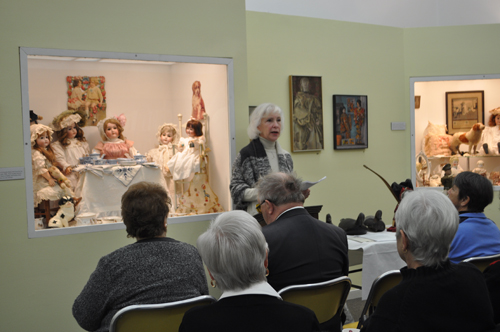To help preserve history, historical societies looking to future

How does a historical society keep from becoming history itself? It was a question on the minds of about 40 local historians Saturday morning in Riverhead.
The historians gathered in the main exhibition gallery of Suffolk County Historical Society for the annual meeting of the Association of Suffolk County Historical Societies.
“What’s going to happen if we don’t get the next generation in the door?” said Dr. Georgette Grier-Key, the ASCHS vice president. “That is the biggest problem. There is definitely a generational gap.”
Participants were there to hear an overview of “Ageless Beauty,” the East Main Street facility’s new doll exhibit, but the day’s more pressing matter came when SCHS executive director Kathy Curran announced she would shortly be mailing surveys to all of Suffolk County’s historical societies in an effort to better understand the needs of those facilities in terms of finances and community outreach.
“I get phone calls every day,” Ms. Curran told attendees. “’We have an old house; what do I do?’ ‘We need to have preservation done on this; where do I go?’ You should have those resources at hand and know who can help you.”
To help facilitate this, she explained, SCHS has partnered with the Center for Nonprofit Leadership at Adelphi University and the Robert David Lion Gardiner Foundation to assess the strengths and weaknesses of the county’s historical societies so that they can grow.
Based in Hampton Bays, the Robert David Lion Gardiner Foundation was founded in 1987. It supports and provides funding to historical societies across Long Island, according to its website. Organizations will not be eligible to receive grant money from the foundation unless they complete the survey, Ms. Curran said.
“What are you doing to make your organization grow?” she asked attendees. “Me, I’m doing the ‘Book and Bottle.’ I’m doing a tea. Are we making money on these events? Not so much … but I’m building the recognition and visibility of [SCHS].”
The survey, which is part of a program called “Looking in the Mirror: Assessing the Strengths, Challenges and Future of our Suffolk County Historical Societies,” will be mailed in April, Ms. Curran said. Focus groups will take place in the summer and a symposium to discuss the questionnaire’s results will be held at SCHS in September.
Securing funding is one of the key problems facing historical societies today, said Dr. Grier-Key, who’s also executive director and chief curator of the Eastville Community Society of Sag Harbor.
“Historical societies are really important because we’re an extension of the education system,” Dr. Grier-Key said. … “It’s our job to educate the public just like libraries and schools, but we’re not given the same funding [through property taxes] libraries and schools are given.”
Writing grant proposals is typically a tedious process, Dr. Grier-Key said, and historical society directors often don’t know who to turn to for guidance. Many organizations don’t have designated staff and the vast majority have aging volunteer boards.
ASCHS president Gail Horton, secretary of Stirling Historical Society in Greenport, said her organization has struggled with funding and outreach in the past but is now doing “much better” because it has bolstered the number of events it hosts and held fundraisers to refurbish its archives building.
“We’re very fortunate,” Ms. Horton said. “We have a walk-in historical society. We’re out there and people come in and they just really love it.”
In Riverhead, Ms. Curran said, the recent placement of large banners advertising the 129-year-old historical society has “drastically increased the amount of traffic we have to the museum.”
But more needs to be done, she said, and addressing those needs in a survey is one way to hopefully achieve results.
For example, Ms. Curran said, “I want handicap access for this building very importantly. I’m missing a gigantic population. …And it’s not just an elderly population or a handicapped population.
“I want mommies in strollers,” she continued. “I want to introduce young children, at a very early age, to a museum and have it be an exciting, user-friendly place.”








